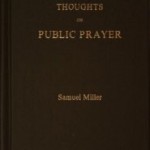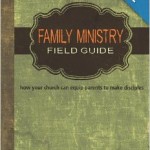I love to read. By God’s grace I am a pretty fast reader; I usually read a couple books each week. I find it helpful to summarize my thoughts on each book and I offer those thoughts in hopes that you will be encouraged to either read or pass over the given title.
 Thought on Public Prayer by Samuel Miller. First published in 1849, Miller’s work goes unnoticed today because I have a suspicion that public prayer is absent from most churches today. This book won’t convince a pastor of public prayer’s necessity as much as it will, Lord willing, increase his ability in public prayer. The first three chapters are somewhat dated as Miller interacts with the contemporary issues of his time, but chapters 4-6 will search the heart. Miller unfolds eighteen “frequent faults” in public prayer and no pastor is outside his scope of criticism. After such bruising Miller offers fourteen “characteristics of a good public prayer” and five “means of attaining excellence in conducting public prayer” to heal the heart. This book has been in print for over 160 years for good reason; if you regularly lead in public prayer it will be of great benefit.
Thought on Public Prayer by Samuel Miller. First published in 1849, Miller’s work goes unnoticed today because I have a suspicion that public prayer is absent from most churches today. This book won’t convince a pastor of public prayer’s necessity as much as it will, Lord willing, increase his ability in public prayer. The first three chapters are somewhat dated as Miller interacts with the contemporary issues of his time, but chapters 4-6 will search the heart. Miller unfolds eighteen “frequent faults” in public prayer and no pastor is outside his scope of criticism. After such bruising Miller offers fourteen “characteristics of a good public prayer” and five “means of attaining excellence in conducting public prayer” to heal the heart. This book has been in print for over 160 years for good reason; if you regularly lead in public prayer it will be of great benefit.
 Family Ministry Field Guide: How Your Church Can Equip Parents to Make Disciples by Timothy Paul Jones. Jones wants to see churches move toward his vision of family ministry: “Intentionally and persistently coordinating a church’s proclamation and practices so that parents are acknowledge, trained, and held accountable as primary disciple-makers in the children’s lives” (33). The book will be most useful for churches wanting to transition from a more programmatic, activity-driven approach to the family ministry approach Jones advocates. Since I came into the book with similar convictions already in place, I didn’t find much that was challenging or new.
Family Ministry Field Guide: How Your Church Can Equip Parents to Make Disciples by Timothy Paul Jones. Jones wants to see churches move toward his vision of family ministry: “Intentionally and persistently coordinating a church’s proclamation and practices so that parents are acknowledge, trained, and held accountable as primary disciple-makers in the children’s lives” (33). The book will be most useful for churches wanting to transition from a more programmatic, activity-driven approach to the family ministry approach Jones advocates. Since I came into the book with similar convictions already in place, I didn’t find much that was challenging or new.
 Trained in the Fear of God: Family Ministry in Theological, Historical, and Practical Perspective edited by Randy Stinson and Timothy Paul Jones. I usually stay away from edited volumes because the quality of content can deviate so much from chapter to chapter. Not so with this volume. It’s strength lies in the three fold evaluation of family ministry; containing chapters from a theological, historical, and practical perspective. I found the historical section to be particular helpful in understanding the various factors contributing to the evolution of family ministry throughout the centuries. David Prince’s chapter on “The Pastor’s Home as Paradigm for the Church’s Family Ministry” was illuminating and challenging. A valuable resource for the pastor’s study.
Trained in the Fear of God: Family Ministry in Theological, Historical, and Practical Perspective edited by Randy Stinson and Timothy Paul Jones. I usually stay away from edited volumes because the quality of content can deviate so much from chapter to chapter. Not so with this volume. It’s strength lies in the three fold evaluation of family ministry; containing chapters from a theological, historical, and practical perspective. I found the historical section to be particular helpful in understanding the various factors contributing to the evolution of family ministry throughout the centuries. David Prince’s chapter on “The Pastor’s Home as Paradigm for the Church’s Family Ministry” was illuminating and challenging. A valuable resource for the pastor’s study.
 Love and War (North and South Trilogy #2) by John Jakes. I loved the first installment of Jakes’ North and South as he quickly captured my attention and ably painted a picture of various American lifestyles found in the 1840-1850s. Thus, I had high expectations for volume two – the longest in the series – as it it completely occupied with The Civil War. Jakes surpassed my expectations in a most surprising way as he chose the lesser known byways of the War of Rebellion. Characters find themselves at the bottom of Charleston harbor inventing a dramatic change in naval warfare; in engineer battalions and military rail crews; inside the horrors of a Confederate prison; across the pond in London as the South builds its ships. The dramatic tension of the first novel is successfully replicated in the second, even if it requires the death of a major character (and my personal favorite). Insightful, harrowing, and real . . . I am eager to read the final volume.
Love and War (North and South Trilogy #2) by John Jakes. I loved the first installment of Jakes’ North and South as he quickly captured my attention and ably painted a picture of various American lifestyles found in the 1840-1850s. Thus, I had high expectations for volume two – the longest in the series – as it it completely occupied with The Civil War. Jakes surpassed my expectations in a most surprising way as he chose the lesser known byways of the War of Rebellion. Characters find themselves at the bottom of Charleston harbor inventing a dramatic change in naval warfare; in engineer battalions and military rail crews; inside the horrors of a Confederate prison; across the pond in London as the South builds its ships. The dramatic tension of the first novel is successfully replicated in the second, even if it requires the death of a major character (and my personal favorite). Insightful, harrowing, and real . . . I am eager to read the final volume.
